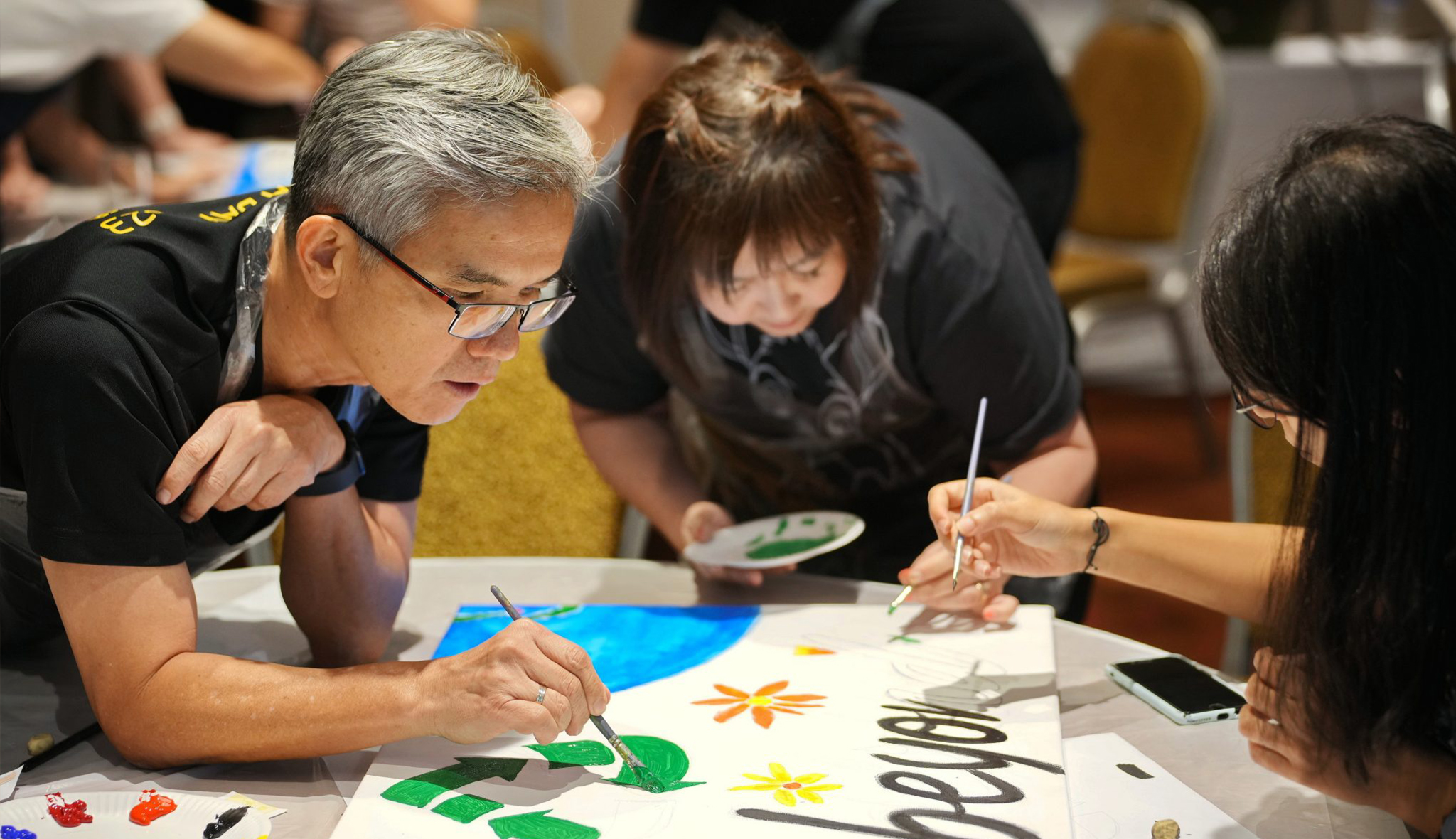Acrylic Painting on Canvas Team Bonding Art Jamming Singapore Visual Arts Centre

























业儿童水墨画书法课程, 新加坡视觉艺术中心带您的孩子开启中国传统艺术之门
在这里,墨水可以赋予纸张生命
每一笔的勾勒都在述说不同的故事
新加坡视觉艺术中心欢迎每一个年轻心灵
从文房四宝里窥见穿越数世纪的精神文明

儿童学习书法的好处有许多,其中最显著的就是可以让孩子们接触到中国传统文化。书法是中国传统文化的重要组成部分,通过学习书法,儿童可以了解汉字的演变和发展历程,感受中国传统文化的魅力,从而促进传统文化的传承和发展。另外,对于孩子自身的发展而言,学习书法可以提高他们的专注力。水墨书法需要细致的动作和专注的态度,通过练习书法,儿童可以培养专注力和耐心,提高集中注意力的能力。其次,练习书法也可以促进孩子们的手眼协调,书法是一种需要精细手部动作的艺术形式,通过书写汉字和练习笔画,儿童可以促进手眼协调能力的发展。儿童学习书法也可以激发他们的兴趣和创造力。通过丰富多彩的书法活动,激发儿童对书法的兴趣和热情,同时鼓励他们发挥想象力和创造力,创作出属于自己的书法作品。

学习书法也可以在精神层面上帮助到孩子们培养美感和审美能力。书法是一种优雅的艺术形式,通过学习书法,儿童可以培养对美的感知能力,提高审美水平,增强对艺术的欣赏和理解能力。另外,学书法还可以促进孩子们的情绪调节能力。书法是一种艺术创作的过程,通过书写和挥毫,儿童可以将自己的情绪和情感表达出来,从而达到情绪调节和释放的作用。最后,学书法还可以提升孩子们的自信心。通过不断练习和进步,儿童可以逐渐掌握书法技巧,提高自己的书写水平,从而增强自信心和自我肯定感。

儿童学习书法首先要掌握正确的姿势和笔法,我们从正确的坐姿,握笔姿势以及基本笔法笔顺开始,确保孩子们有良好的书法习惯,这对于后续的书法学习至关重要。其次,要学好书法需要孩子们加大汉字认字量。从简单的笔划开始,我们选择一些基础的笔划,如横、竖、撇、捺等,让儿童逐步掌握汉字的结构,然后再循序渐进地让孩子们接触到更多的汉字。写得一手好书法离不开模仿优秀书法作品。 让儿童模仿优秀的书法作品,可以让他们学习前人的书法的风格和技巧。因此我们可以选择一些简单易懂的篆书或楷书作品,让儿童跟随练习。最后一点,儿童学习书法需要培养他们的耐心和毅力。学习书法是一个持续的过程,我们鼓励儿童在学习书法的道路上坚持下去,不轻易放弃。因此我们可以设定一些小目标和奖励,激励他们坚持练习。


写得一手好书法离不开模仿优秀书法作品。 让儿童模仿优秀的书法作品,可以让他们学习前人的书法的风格和技巧。因此我们可以选择一些简单易懂的篆书或楷书作品,让儿童跟随练习。最后一点,儿童学习书法需要培养他们的耐心和毅力。学习书法是一个持续的过程,我们鼓励儿童在学习书法的道路上坚持下去,不轻易放弃。因此我们可以设定一些小目标和奖励,激励他们坚持练习。


Address:
10 Penang Road, #01-02 Dhoby Ghaut Green,
Singapore 238469
Exit from Dhoby Ghaut MRT Station Exit B and turn left, we are there in 30m!

Address:
AZ@Paya Lebar, 140 Paya Lebar Road, #03-04,
Singapore 409105
Exit from Macpherson MRT Station Exit A and turn left, we are right across the road, 1 minute walk away!

10 Penang Road,
#01-02 Dhoby Ghaut Green,
Singapore 238469
140 Paya Lebar Road,
#03-04 AZ@Paya Lebar Building,
Singapore 409015
6255 0711
info@visualartscentre.sg
62550711
67332155
Dhoby Ghaut Art Studio
Monday to Sunday: 11am – 8pm
Closed on Public Holidays, except by appointment.
MacPherson [Office & Storage]
By appointment only
Visual Arts Centre is an exhibition gallery and art studio at Dhoby Ghaut Green supported by the National Parks Board and the National Arts Council.
Since its initiation on 31 January 2016, the Visual Arts Centre Exhibition Gallery has hosted over two hundred international and local art and design exhibitions, boasting a diverse range of art styles and programmes.
Email:
info@visualartscentre.sg
Phone:
+65 6255 0711
+65 6733 2155
Featured Courses 推荐课程
Art Immersion 3 Medium Course 综合媒介绘画课
Drawing & Sketching Course 素描课程
Acrylic Painting Course 丙烯画课程
Watercolour Painting Course 水彩画课程
Oil Painting Course 油画课程
Chinese Ink Painting Course
Trial Sessions 试课
Chinese Calligraphy & Ink Painting
Graffiti Spray Painting Course
Portfolio Preparation Course (Process) 作品集 (DSA)
Portfolio Preparation Course (Process) 作品集 (Diploma)
Professional Manga Drawing & Digital Painting Course
Professional Interior Design & Freehand Rendering Course
Outdoor Urban Landscape Sketching Course
Private Art Classes
Creative Kids Art Immersion Course 儿童创意绘画课程
Holiday Art Courses & Bootcamps
2025: Holiday Art Course for Kids & Teens 儿童和青年假期课程
2025 Kids (6-9YO) Holiday Art Course 儿童假期课程
2025 Teens (10-18YO) Holiday Art Course 青年假期课程
2025 Art Competition ( Life in an AI-Era ) Open for Registration!
2025新加坡“AI时代的梦想”儿童与青少年绘画大赛开始报名!
Team Building Art Jamming
Art Jamming Team Bonding Catalogue
Team Bonding
Gala Dinner Art Workshop
Batik Painting Workshop (Mural / Individual)
Graffiti Spray Painting on Canvas Workshop
Kids Birthday Party - Art Jamming
Kids T-Shirt Painting Art Party
Batik Painting Workshop
Graffiti Spray and Paint Workshop
Therapeutic Mental Health Workshops
Art Workshop
Workshops at SAM During SAW 2025
Digital Dreams - Transforming Ideas Into Art
Nude Life Drawing with Artist Guidance
Portrait Life Drawing with Artist Guidance
Chinese Ink Painting
Chinese Calligraphy & Ink Painting
Current & Upcoming Exhibitions
Mother's Day Portrait Painting
KINDNESS IN INK - HARMONY IN ART
Personal Colour Consultant Certification Course
Venue Hire 场地出租
Hire of Visual Arts Centre Exhibition Gallery @ Dhoby Ghaut
Visual Arts Centre Exhibition Gallery @ Dhoby Ghaut
Visual Arts Centre Gallery and Studio @ MacPherson
Special Art Jamming Themes
Chinese New Year Art Jamming
Art Workshops for Singles and Dating
Women's Day
Labour's Day
National Day
Mid Autumn Festival
Deepavali Art Jamming
Halloween Art Jamming
Christmas Art Jamming
View More
Best Team Building Activity
Art Jamming Team Bonding Catalogue
零基础自助绘画(Art Jamming )工作坊
Kids Art Jamming Birthday Party Workshops
艺术生日派对-DIY粘土主题
Art Birthday Party With Diy Clay
Art Birthday Party With Tote Bag Painting 艺术生日派对-画托特包主题
Birthday Party With T-shirt Painting
艺术生日派对-画T恤衫主题
Art Competition and Affordable Art Fair Workshops
Children and Youth Art Competition 2025 – “Life in an AI-Era”
(Embracing Nature) Children and Youth Art Competition
Workshops & Fair Activities
Venue Hire
10 tips for a successful pop-up flea market event
Beautiful Space in the City Central
A Perfect Art Venue for Hire
What to consider when renting a venue for your fashion shows and pop-ups?
Art Course
Where to learn Professional Chinese calligraphy course in Singapore?
艺术疗愈如何让你心理更健康
Best Professional Art Courses In Singapore
在新加坡哪里能学专业素描/速写、油画、水彩、丙烯、水墨、艺术作品集准备、儿童美术、儿童青少年书法等专业美术绘画课?
在新加坡哪里学习专业书法课程?学习书法对儿童青少年的好处
View More
Art Portfolio Preparation - DSA (Kids)
凭什么,新加坡乌节路寸土寸金的商业宝地竟给国人当画室? 快!带你去看看!
Singapore Holiday 2025 - Learn Digital Landscape Painting and Manga Drawing
成人画画课就在视觉艺术中心
Applying into Art Schools - How does one build an art portfolio?
Others
Best Professional Manga Drawing Drawing Course in Singapore
对南洋画派新加坡第一代艺术先驱作品的印象
定制贵宾晚宴的艺术项目
Art Buzz: How to Appreciate Art?
《纪念刘抗诞辰111周年—刘抗书画遗作展》
10 Reasons to Learn Drawing and Sketching
View More
Art Therapy Course in Singapore!
Overseas Students Art & Cultural Exchange
Commissioning Custom made portraits/nude life by professional artists
FAQs for Art Portfolio Preparation - DSA, Diploma & Higher Education
Click and get to our WhatsApp
In the Batik Introduction Handkerchief Painting workshop, participants will learn the traditional art of batik, a wax-resist dyeing technique originating from Indonesia. The workshop begins with a brief history and overview of batik, highlighting its cultural significance and various techniques. Participants will then observe a demonstration of applying wax with tjanting tools and dyeing the fabric. Following the demonstration, each participant will design and create their own batik handkerchief, applying wax to create patterns and then dyeing their fabric. The workshop concludes with a group discussion, allowing participants to share their creations and reflect on their learning experience.